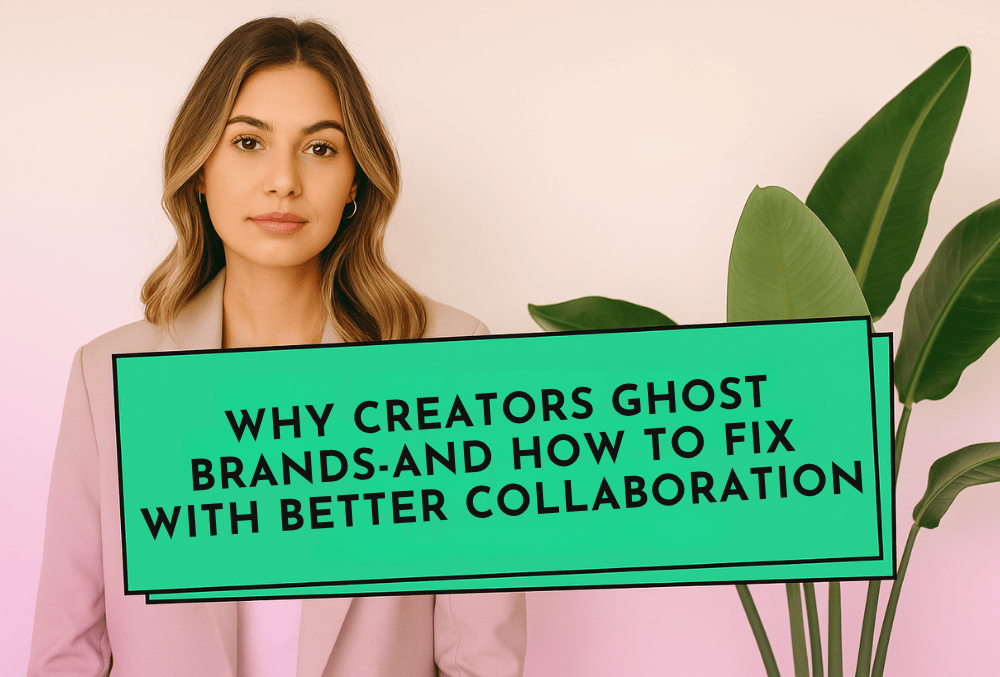Ever had a creator disappear midway through a campaign? You’re not alone. Creator ghosting is a growing issue in influencer marketing, often caused by gaps in communication, unclear expectations, or lack of trust. In this blog, we break down why creators ghost brands and how better collaboration tools and processes can help keep partnerships strong and consistent.
The Rise of Creator Drop-Offs
You’re not alone. According to industry estimates, over 37% of influencer collaborations face some form of mid-campaign dropout or communication lapse. In an era where digital storytelling drives conversions, ghosting isn’t just inconvenient—it’s costly.
Consistency is the secret sauce in influencer marketing. When creators vanish, it creates gaps in the brand narrative, interrupts buyer journeys, and erodes campaign momentum.
So, why do creators ghost brands, and more importantly, how can you prevent it? Let’s dive deep.
Why Do Creators Ghost Brands?
Understanding the root cause is the first step to prevention. Here are the most common influencer drop-off reasons and how they originate.

1. Unclear Briefs or Expectations
Creators thrive when they understand the vision. But when brands send generic or last-minute briefs, it creates confusion, hesitation, and disengagement.
- Lack of clarity can make creators feel undervalued.
- It also increases the chances of multiple content revisions later.
2. Poor Communication Frequency
Initial enthusiasm often fades when communication dries up. A week of silence can easily be interpreted as disinterest.
- Regular check-ins keep creators aligned and motivated.
- Absence of feedback may lead them to deprioritize your campaign.
3. Delayed Payments or Complicated Invoicing
Nothing breaks trust faster than payment delays. Creators, like any professionals, expect timely compensation.
- Complex payment systems create bottlenecks.
- Chasing invoices discourages creators from future collaborations.
4. Last-Minute Creative Changes or Endless Revisions
Revisions are fine—within reason. But surprise changes and vague feedback can make creators feel like their creative input isn’t respected.
- It leads to frustration and slow delivery.
- Inconsistent messaging confuses both the creator and their audience.
When evaluating why creators ghost brands, these overlooked issues often hold the answers.
The Domino Effect: What It Costs Your Brand
Ignoring the above problems doesn’t just affect one campaign—it creates a ripple effect across your influencer ecosystem.

1. Missed Campaign Timelines and Deliverables
A single missed Reel or YouTube post can derail product launches or seasonal promotions. It reflects poor coordination to both your team and your audience.
2. Damaged Brand Credibility
When creators ghost, it signals internal chaos. That perception, even if false, affects your reputation in the creator economy.
3. Wasted Influencer Marketing Budgets
Whether it’s a paid collaboration or a barter campaign, your budget takes a hit. Missed posts equal missed impressions, engagement, and conversions.
4. Negative Word-of-Mouth Among Creators
Creators talk. A poor experience can spread fast within influencer circles, making future recruitment harder and costlier.
The takeaway? Failing to address the influencer brand communication gap leads to long-term brand damage.
Collaboration Fixes That Actually Work
Solving the ghosting problem isn’t about over-controlling creators. It’s about providing clarity, respect, and structure.

1. Set Clear, Pre-Agreed Timelines
Avoid confusion with upfront campaign timelines that detail:
- Draft deadlines
- Review and feedback phases
- Final post schedule
2. Approve Concepts Early
Early concept approvals help creators align their tone and visuals with your brand identity. It also:
- Reduces feedback loops
- Avoids last-minute rewrites or delays
3. Ensure Fair and Fast Payments
Use reliable payment systems and respect creator payment terms.
- Automated payouts can increase creator satisfaction.
- Payment transparency also builds trust.
4. Share Campaign Milestones via Dashboards
A shared dashboard acts as a real-time collaboration board where both sides can:
- Monitor status
- Check off deliverables
- Provide feedback without emails getting lost
Implementing a transparent creator collaboration workflow improves communication and minimizes drop-offs.
How Sociocreator Solves This Problem
Sociocreator is a campaign engine for influencer marketing built to solve the ghosting problem at its root. It redefines how to manage influencer relationships through smart systems and automation.
Conclusion: Shift from Transactional to Trust-Based Campaigns
If you want lasting success with influencers, treat them like long-term collaborators—not temporary hires.
Instead of constantly asking why creators ghost brands, brands should focus on building trust, clarity, and mutual respect.
Structure and transparency are what transform one-time deals into recurring partnerships. And Platforms like Sociocreator make that transformation not only possible but scalable.
FAQs
1. Why do creators ghost brands during influencer campaigns?
Creators often disengage due to unclear briefs, delayed payments, inconsistent communication, or lack of creative freedom. These factors erode trust and motivation.
2. How can brands prevent influencers from abandoning collaborations?
Use a structured workflow, approve content early, and ensure timely payments. Building a relationship rather than treating them like a one-off hire also helps.
3. What role does a CRM play in influencer marketing?
An influencer CRM platform helps track communication, tasks, deliverables, and payment status—streamlining the entire campaign process and improving creator retention.
4. How does Sociocreator help reduce creator ghosting?
Sociocreator combines CRM, workflow automation, payment processing, and campaign visibility in one platform, reducing the chances of creator drop-off.
5. What should be included in a creator collaboration workflow?
Timelines, deliverables, concept approvals, payment milestones, communication logs, and feedback loops—all managed in one transparent space.

